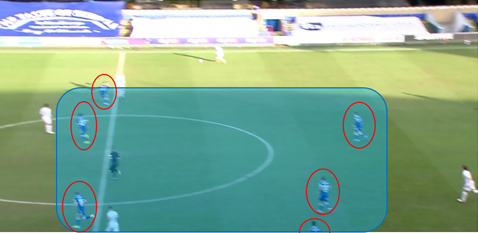Karl Robinson admitted he had received multiple loan offers for Mark Sykes in January.
Given the Irish midfielder had been out in the cold since the derby day collapse to Swindon, a temporary move seemed fitting for all parties.
Robinson, however, has spoken of Sykes in glowing terms and insisted the former Glenavon man has a part to play in the end of Oxford's season.
His words have been backed up by three consecutive starts for Sykes and - arguably - three man of the match performances.
It has been the intelligence of Sykes that has really shone during a return to the side.
We all know Sykes has the tricks, flicks and an occasional roulette turn, but so often his decision making has let him down at crucial times.
His recent performances, though, seem more fitting of a true number ten.
Elliot Lee proved to be the perfect foil for Sykes, who started against Ipswich on the right of a midfield trio, but often found himself drifting wide and switching with Lee.
Add to this Anthony Forde playing at right back, and you had an entire right side drifting both inside and out, causing a different kind of headache to the blaring pace of Brandon Barker on the opposite flank.
It didn't take long for the interchanging of positions to show.
 |
The still above - if you can see past the glaring sunlight which encompassed the far side for much of the afternoon - illustrates the positioning of the players.
Taken from just the 15th minute, it depicts Elliot Lee drifting inside and Mark Sykes intelligently taking the space outside him as a makeshift inside forward.
His tendency to not hug the touchline, though, allows the space for Anthony Forde down the right wing, stretching the pitch as far as possible.
Though this ball from Gorrin was wayward, the movement of Sykes and Lee to spread the width of the pitch was evident throughout, and allowed United to unleash their real weapon - the pace of Barker.
Ipswich set up in a narrow formation, with Norwood and Parrot - who would join the former up front in the second half - cutting inside proving their main threats, and Bennetts also looking to cut in from the right more often than not.
This (below) is the same image as the one previously shown, but this time it highlights the positioning of Ipswich's players.
 |
There are six Ipswich players occupying the central area of the pitch, with only Brannagan, Sykes and Lee remotely close to them.
It meant it would always be a tough day for the midfield, and instead the space would come out wide.
Sykes - among others - used his movement to drift around the pitch, creating space in these wide areas and attracting markers inside.
The passage of play above - although not coming to anything - perfectly depicts the positioning of Sykes and Lee to create space in the channels, and allowing Forde to hug the touchline, which in turn shifted Ipswich across and allowed Barker to be more isolated one on one with the full back.
Its the kind of unselfish movement that we haven't seen much from Sykes, but the sort that a number 10 does for a living.
Sykes' movement and intelligent positioning continued throughout the game - hopefully losing his tendency to drift out of matches.
The above image is taken from a few minutes later, but mirrors the last passage of play almost exactly.
Lee drifts inside, Sykes occupies the inside right channel to drag the winger across and allows Forde the space to break into.
You can once again notice the six Ipswich players occupying the central third, leaving an overload on the wings.
This time it is Brannagan playing a more effective ball and Forde is able to pounce on to it, but the ball bounces unfortunately and Forde's control takes him backwards.
This, though, does not mean Sykes switches off.
The ball is recycled backwards - through Sykes - who then cleverly moves into the space left by Forde on the wing.
After Moore drives the ball into Lee, Sykes has found the space and made the run to get in behind.
This time, Lee - inexplicably given his intelligence - decides to cut back rather than play the simple ball in behind.
Sykes continually made these runs from both midfield and the wing, and proved Oxford's biggest threat other than Barker.
Only Barker (8) and Bennetts (5) had more dribbles than Sykes out of the 29 players on show.
His performances in recent games have been a perfect mix of his usual flair and more intelligent movement off the ball.
His ability to seamlessly switch between the wing and midfield has been a useful weapon for Robinson, and his displacement of Henry from the team is great credit to the faith being shown in him from Robinson.
 |
| Sykes touch map vs Ipswich (Whoscored.com) |
Sykes' touch map against Ipswich depicts a player who doesn't need to be on the ball to affect the game.
Despite playing over a half in central midfield, he mostly affected the game on the ball from the wing, but many fans would say he remained Oxford's most dangerous player from the middle of the park.
Its a quality which has been missing from Sykes' game for as long as he's been at the club.
Wary of getting too excited too early - there have been several false horizons before - but at the moment, Sykes is proving why Robinson's faith in him is justified.
His clever movement is restoring him to the player that earnt a place - and scored - in the playoff final, and McGuane and Henry may find their positions in more jeopardy once back to full fitness.


Comments
Post a Comment